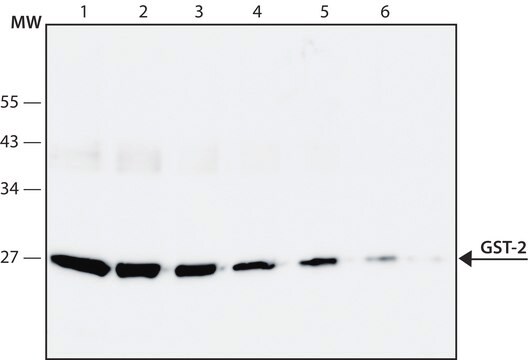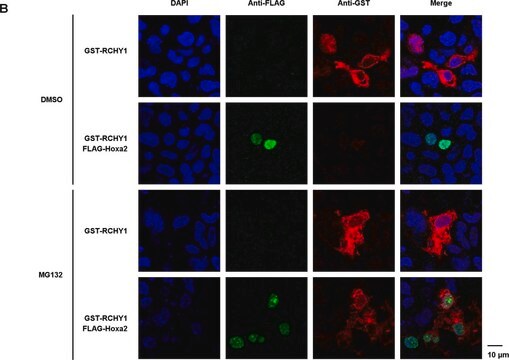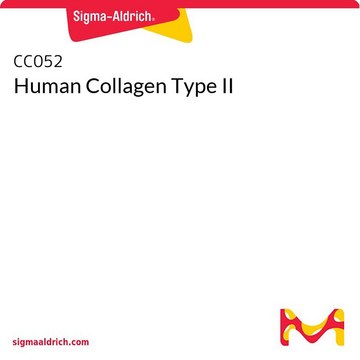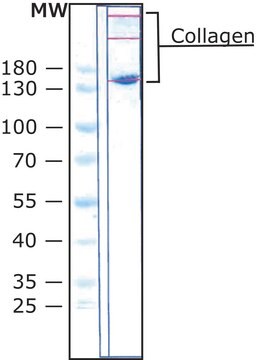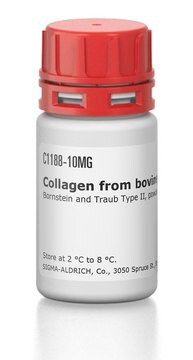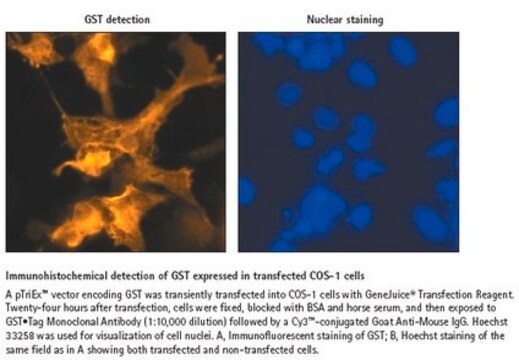추천 제품
생물학적 소스
mouse
Quality Level
결합
unconjugated
항체 형태
ascites fluid
항체 생산 유형
primary antibodies
클론
GST-2, monoclonal
포함
15 mM sodium azide
기술
dot blot: suitable
indirect ELISA: suitable
western blot: 1:1,000 using purified recombinant GST or lysate of induced bacteria expressing recombinant GST
동형
IgG2b
배송 상태
dry ice
저장 온도
−20°C
타겟 번역 후 변형
unmodified
일반 설명
Monoclonal anti-glutathione-S-transferase (GST) (mouse IgG2b isotype) is derived from the GST-2 hybridoma produced by the fusion of mouse myeloma cells and splenocytes from a BALB/c mouse immunized with a purified recombinant GST fusion protein.GST belongs to three family of proteins distinguished as cytosolic, mitochondrial and microsomal GST. At present, eight distinct classes of the soluble cytoplasmic mammalian glutathione S-transferases have been identified: α, κ, μ, ω, σ, θ, π and ζ.
Recombinant target proteins are often expressed as a fusion product with Glutathione-S-Transferase (GST) tags using various expression vector constructs. Thus, antibodies directed against the GST tags of the recombinant constructs can facilitate the purification and study of target proteins. Monoclonal Anti-Glutathione-S-Transferase (GST) antibody reacts with GST from Schistosoma japonicum. Furthermore, the product identifies native as well as denatured-reduced forms of purified GST and GST fusion proteins. The antibody does not detect GST derived from rat, rabbit, porcine and bovine liver or from human placenta.
면역원
recombinant Glutathione-S-Transferase (GST) fusion protein.
애플리케이션
Monoclonal Anti-Glutathione-S-Transferase (GST) antibody has been used for use in western blot and ELISA. This product has also been used for dot blot.
생화학적/생리학적 작용
Glutathione S-transferases (GSTs) are a family of enzymes that play an important role in detoxification by catalyzing the conjugation of many hydrophobic and electrophilic compounds with reduced glutathione.
면책조항
Unless otherwise stated in our catalog or other company documentation accompanying the product(s), our products are intended for research use only and are not to be used for any other purpose, which includes but is not limited to, unauthorized commercial uses, in vitro diagnostic uses, ex vivo or in vivo therapeutic uses or any type of consumption or application to humans or animals.
적합한 제품을 찾을 수 없으신가요?
당사의 제품 선택기 도구.을(를) 시도해 보세요.
Storage Class Code
12 - Non Combustible Liquids
WGK
nwg
Flash Point (°F)
Not applicable
Flash Point (°C)
Not applicable
시험 성적서(COA)
제품의 로트/배치 번호를 입력하여 시험 성적서(COA)을 검색하십시오. 로트 및 배치 번호는 제품 라벨에 있는 ‘로트’ 또는 ‘배치’라는 용어 뒤에서 찾을 수 있습니다.
이미 열람한 고객
Young C Shin et al.
Cancer research, 68(6), 1751-1759 (2008-03-15)
Kaposi's sarcoma-associated herpesvirus (KSHV) is the etiologic agent associated with Kaposi's sarcoma, primary effusion lymphoma, and multicentric Castleman's disease. Hypoxia-inducible factor-1 (HIF-1) is the master regulator of both developmental and pathologic angiogenesis, composed of an oxygen-sensitive alpha-subunit and a constitutively
Björn Titz et al.
Journal of bacteriology, 188(21), 7700-7706 (2006-08-29)
TP0658 (FliW) and its orthologs, conserved proteins of unknown function in Treponema pallidum and other species, interact with a C-terminal region of flagellin (FlaB1-3 in T. pallidum; FliC in most other species). Mutants of orthologs in Bacillus subtilis and Campylobacter
Daniel Spazierer et al.
Journal of cell science, 121(Pt 6), 825-833 (2008-02-21)
Epiplakin is a large (>725 kDa) cytoskeletal protein exclusively expressed in epithelial tissues. It has a unique structure, consisting entirely of plakin repeat domains (PRDs), one of the hallmarks of spectraplakin protein family members. Previous studies, including the phenotypic analyses
Structure, function and evolution of glutathione transferases: implications for classification of non-mammalian members of an ancient enzyme superfamily.
Sheehan D, et al.
The Biochemical Journal, 360(1), 1-16 (2001)
Anna Brotcke et al.
Infection and immunity, 76(8), 3473-3480 (2008-06-19)
Francisella tularensis infects wild animals and humans to cause tularemia. This pathogen targets the cytosol of macrophages, where it replicates using the genes in the Francisella pathogenicity island (FPI). Virulence gene regulation in Francisella is complex, but transcriptional regulators MglA
자사의 과학자팀은 생명 과학, 재료 과학, 화학 합성, 크로마토그래피, 분석 및 기타 많은 영역을 포함한 모든 과학 분야에 경험이 있습니다..
고객지원팀으로 연락바랍니다.